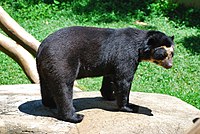
Photo from wikipedia
Context Habitat suitability models (HSM) can improve our understanding of a species’ ecology and are valuable tools for informing landscape-scale decisions. We can increase HSM predictive accuracy and derive more… Click to show full abstract
Context Habitat suitability models (HSM) can improve our understanding of a species’ ecology and are valuable tools for informing landscape-scale decisions. We can increase HSM predictive accuracy and derive more realistic conclusions by taking a multi-scale approach. However, this process is often statistically complex and computationally intensive. Objectives We provide an easily implemented, flexible framework for sequential multi-level, multi-scale HSM and compare it to two other commonly-applied approaches: single-level, multi-scale HSM and their post-hoc combinations. Methods Our framework implements scale optimisation and model tuning at each level in turn, from the highest (population range) to the lowest (e.g. foraging habitat) level, whilst incorporating output habitat suitability indices from a higher level as a predictor. We used MaxEnt and a species of conservation concern in Britain, the lesser horseshoe bat ( Rhinolophus hipposideros ), to demonstrate and compare multi-scale approaches. Results Integrating models across levels, either by applying our framework, or by multiplying single-level model predictions, improved predictive performance over single-level models. Moreover, differences in the importance and direction of the species-environment associations highlight the potential for false inferences from single-level models or their post-hoc combinations. The single-level summer range model incorrectly identified a positive influence of heathland cover, whereas sequential multi-level models made biological sense and underlined this species’ requirement for extensive broadleaf woodland cover, hedgerows and access to buildings for roosting in rural areas. Conclusions We conclude that multi-level HSM appear superior to single-level, multi-scale approaches; models should be sequentially integrated across levels if information on species-environment relationships is of importance.
Journal Title: Landscape Ecology
Year Published: 2020
Link to full text (if available)
Share on Social Media: Sign Up to like & get
recommendations!